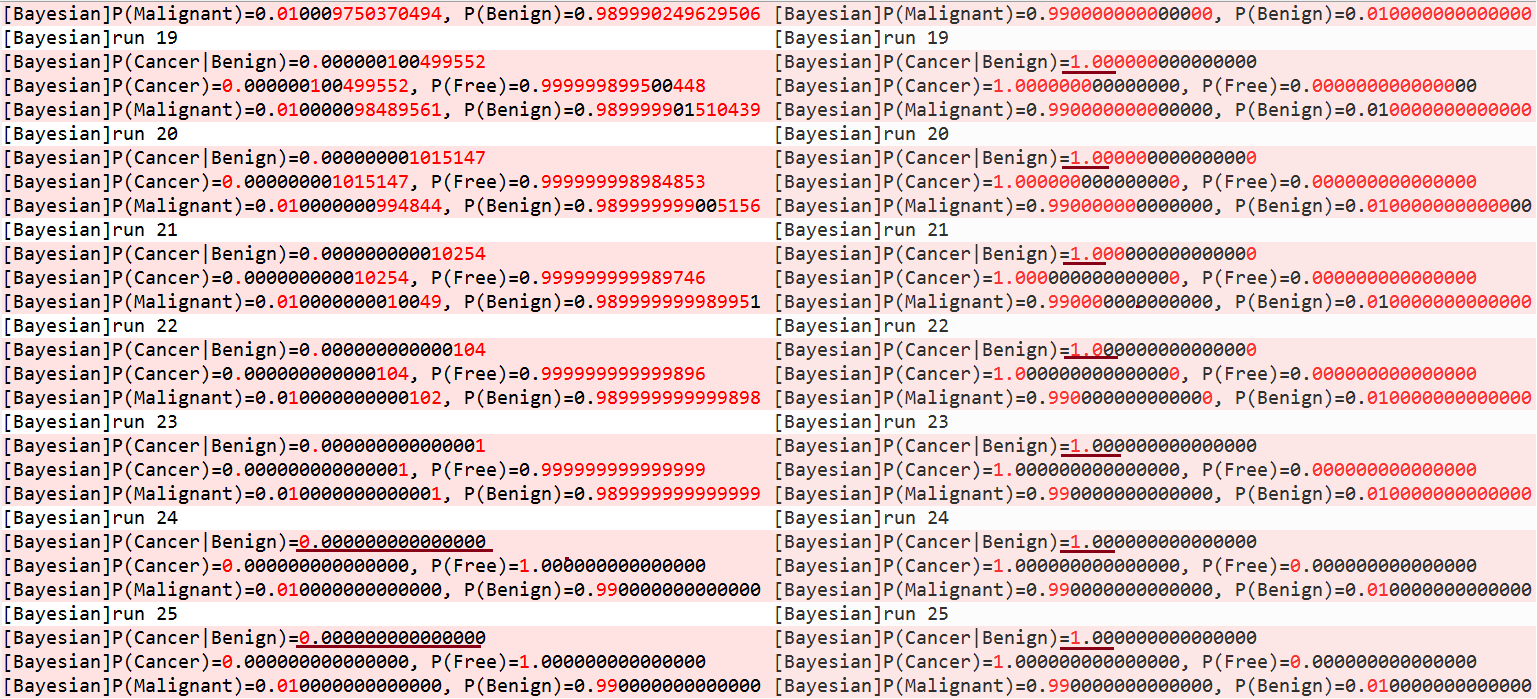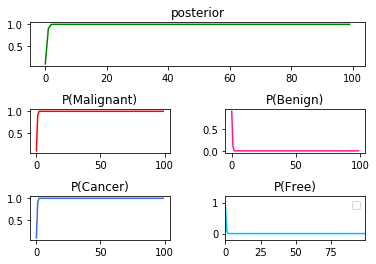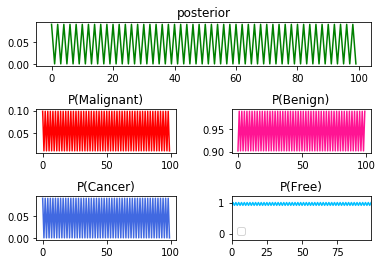The Bayesian Inference Exploitation
17 Jun 2018Prologue To The Bayesian Inference Exploitation
Prepare to Exploit The Bayesian Inference
[1] ReCap The bayesian inferenceWe can characterize how one’s beliefs ought to change when new information is gained.
Remember the illustration example in the The Bayesian Thinking, I have show you by contiguous update the given prior by the estimated posterior would we obtain the desired result by reinforcement.
[2] The question in mindFrom #1, #2, #3 tests, by feeding the prior with the positive posterior estimation, then we get almost $100\%$ in $P(Cancer\vert Malignant)$. Below are the unknowns:
[3] The stress test
➀how, if we update the given prior several times with the positive posterior estimation, $P(Cancer\vert Malignant)$, laterly make contiguous negative posterior estimation, $P(Cancer\vert Benign)$?
➁will we have the chance to increase the negative posterior estimation, in its probability, $P(Cancer\vert Benign)$?
➂for the answer of yes and no, could we describe the exact trend of $P(Cancer\vert Benign)$?
➃or, is there some condition far beyond our naive beliefs that prior updated by some amount of positive posterior, we can concrete the negative posterior?Below is my stress test flow:
➀the rule of updating prior by the estimated posterior remains the same, when we make estimation of $P(Cancer\vert Malignant)$ and $P(Cancer\vert Benigh)$, at the end of each test, we do the update job.
➁by executing $P(Cancer\vert Malignant)$ in $i$ times, next to execute $P(Cancer\vert Benign)$ over $100-i$, where $i$=$1$ to $100$.
➂below graph exhibits the result of $P(Cancer\vert Malignant)$x${i}$, $P(Cancer\vert Benign)$x$(100-i)$ for the first 12 tests:
The results are depicting from the left, top to the right, low in orders. For the simplicity, I denote $P(C\vert T)$ as $P(Cancer\vert Malignant)$, $P(Cancer\vert F)$ as $P(Cancer\vert Benign)$.
➃trivially, $P(C\vert T)$x$9$ to $P(C\vert T)$x$10$ is the major point, after positive posterior over $10$ times, the following negative posterior won't be decreased, and keeps the same result as the latest positive posterior!
Exploit The Bayesian Inference
Next we investigate what positive posterior over $10$ times has put inside the whole process, such that the following up $90$ negative posteriors would not downgrade the probabilistity of $P(Cancer\vert Benigh)$.
[1]By comparing the statistical log info of $P(C\vert T)$x$9$ and $P(C\vert T)$x$10$
The $P(Free)$ and $P(Benign)$ are compounded slowly increasing, the root cause to gradually decrease $P(Cancer\vert Benign)$!!
The test is 0-index based in my log, so you see run 9 is actually the 10-th execution of the test:
➀the log comparison reveals that the run #9 in $P(C\vert T)$x$9$, the left side, says $P(Cancer\vert Benign)$ is almost $1$, but not yet!
➁the right side result, the run #9 in $P(C\vert T)$x$10$ says $P(Cancer\vert Malignant)$ is equivalent to $1$!
➂the left side $P(C\vert F)$x$9$ has its $P(Cancer)$ and the total probability of $P(Malignant)$ downgraded, since the negative posterior is thus estimated:
$P(Cancer\vert Benign)$=$\frac {P(Benign\vert Cancer)\cdot P(Cancer)}{P(Benign)}$
$P(Benign)$=$P(Benign\vert Cancer)\cdot P(Cancer)$
$\;\;\;\;$+$P(Benign\vert Free)\cdot P(Free)$➃the right side $P(C\vert T)$x$10$, from the run #9(10-th) test of $P(Cancer\vert Malignant)$, we have $P(Cancer)$=$1$, $P(Free)$=$0$ keep invariant change in the total probability of $P(Malignant)$ and $P(Benign)$.
➄continue to inspect the log comparison result, we can see that in the series of $P(C\vert T)$x$9$, $P(C\vert F)$x$91$, the negative posterior becomes smaller and finally to 0; nevertheless, the $P(C\vert T)$x$10$, $P(C\vert F)$x$90$, we have $P(Cancer\vert Benign)$=$1$ all the way to the test end.
[2]Deeper inside $P(C\vert T)$x$9$ and $P(C\vert T)$x$10$
To make my findings concrete, the statistical summary of the 2 series are given in below graphs:
➀below graph illustrates the consistency of my finding is of no doubt in $P(C\vert T)$x$9$.
➁the same in $P(C\vert T)$x$10$.
[3]Other testing reports
At the end of this article, I depict all stress test I have done.
➀it is the result of $P(Cancer\vert Malignant)$x$100$:
➁it is the result of $P(Cancer\vert Benign)$x$100$:
➂below exhibits the result in the series $P(Cancer\vert Malignant)$x$50$, then $P(Cancer\vert Benign)$x$50$:
➃the result in the series $P(Cancer\vert Malignant)$,then $P(Cancer\vert Benign)$ as a whole the pattern for the behavior in the rest process:
You can tell that the patterned toggling exist for all terms of probability.
All above reports are generated by my Python simulator. The related logs are downloaded here, $P(Cancer\vert Malignant)$ over $9$ times and $P(Cancer\vert Malignant)$ over $10$ times.


